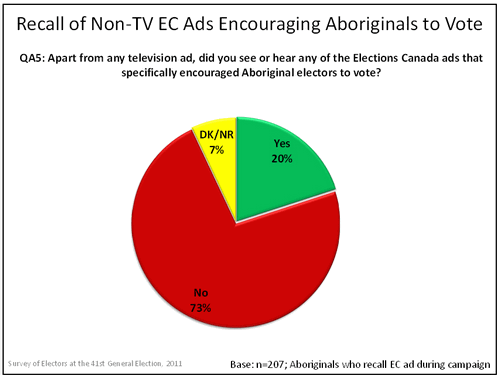Survey of Electors Following the 41st General Election
Appendix 1: Aboriginal Electors
This section addresses Aboriginal electors. Aboriginal Canadians include First Nations, Métis, and Inuit.
Aboriginal Groups
For the purpose of this study, an oversample of 526 Aboriginal respondents was collected – making for about 4% of the sample. In terms of the various identity groups, 332 respondents reported to be First Nations, 164 Métis and 27 Inuit (3 refused to specify).
Status and Non-Status Indians
The great majority (89%) of First Nations respondents are Status Indians. Seven percent are Non-Status Indians, and 3% either said they did not know or did not respond.
On vs. Off Reserve
First Nations and Métis respondents were asked whether their primary residence is located on a reserve. Just over half (53%) said it is not, while 45% said it is. Two percent did not know or did not respond.Footnote 24
Of those who live on a reserve, 55% reported that there was a polling station on their reserve. Conversely, roughly a quarter (24%) said there was not, while 21% did not know or did not respond.
The likelihood of reporting having voted in the 2011 election did not differ in a statistically significant manner between Aboriginal electors living on a reserve from those living off a reserve (65% and 69% respectively). Aboriginal electors living off a reserve, however, were more likely to report having voted in their last provincial election (69% vs. 58% living on a reserve). They were also more likely to trust the accuracy of election results in their riding (73% vs. 58% living on a reserve), and to report following the campaign closely (63% vs. 51% living on a reserve). Interestingly, Aboriginals living on a reserve were more likely than those living off a reserve to say that their address was correct on their Voter Information Card (99% vs. 94%).
Variety of Suggestions to Encourage Aboriginals to Vote
Aboriginal respondents offered a variety of suggestions for encouraging Aboriginal people to vote in federal elections. Roughly one in ten suggested more education or information about the voting process (10%), more campaigning or information from candidates directed to Aboriginals (10%), better communication with Aboriginals, including information in their language (10%), and better treatment of Aboriginals and Aboriginal issues (9%). Smaller numbers recommended having polling stations on reserves or transportation to polling stations (7%), more encouragement to vote (5%), and more Aboriginal candidates (4%). A few suggested online voting (1%).
Forty-seven percent of Aboriginal respondents did not offer any suggestions. Eight percent specified that nothing should be done, and nearly 39% said they do not know or did not respond.

Text description of "Means of Encouraging Aboriginals to Vote" graph
Most Did Not Recall EC Ads Encouraging Aboriginals to Vote
Aboriginal electors who indicated having noticed an advertisement from Elections Canada about the general election were asked whether, apart from any television ad, they had seen or heard any of the Elections Canada ads that specifically encouraged Aboriginal electors to vote. The majority (73%) said they did not recall any such advertisement, while 20% said they did. By contrast, the proportion of Aboriginal respondents who did not recall such advertising was 75% in 2006 and 78% in 2008.
Text description of "Recall of Non-TV EC Ads Encouraging Aboriginals to Vote" graph
Mainstream Media – Main Source for Aboriginal-Directed Advertisements
Of those Aboriginal electors who said they had seen or heard Elections Canada ads that specifically encouraged Aboriginal electors to vote (n=49), most identified mainstream media as the source of these ads. Despite the instruction to exclude TV, the largest proportion (n=21) identified television, followed by newspapers (n=15), and radio (n=12). One in ten (n=5) mentioned signs/posters/billboards, while smaller numbers identified non-Elections Canada websites (n=3) and brochures/flyers (n=1). Sources identified by 2% or less, categorized as "other", include the candidates themselves, and word of mouth.

Text description of "Source of Advertisements Encouraging Aboriginals to Vote" graph
Reminder, Encouragement to Vote – Top Message Recalled of Aboriginal Ads
Not surprisingly, Aboriginal electors who recalled having seen or heard Elections Canada ads that specifically encouraged Aboriginal electors to vote (n=49) tended most often to remember such ads offering a reminder/enticement/encouragement to vote (n=34). Other substantive elements recalled from these ads included messages relating to the importance of voting (n=8), the election date(s) (n=3), where to vote (n=1), and voting hours (n=1).
In terms of their evaluation of these ads, a strong minority (42%; n=21) said that they liked them, with 14% (n=7) saying they liked them a lot. Roughly half (n=24) offered no opinion on the ads or said they didn't know. Relatively few said they disliked the ads.
Most Voted in Last Band Election
Most Aboriginal electors who lived on a reserve said they had voted in their last band election (80%). One in five said they had not.
Text description of "Voted in Last Band Election" graph
Return to source of Footnote 24 The proportions of Aboriginals living on vs. off a reserve are a result of quotas set to ensure adequate sampling from each group.
